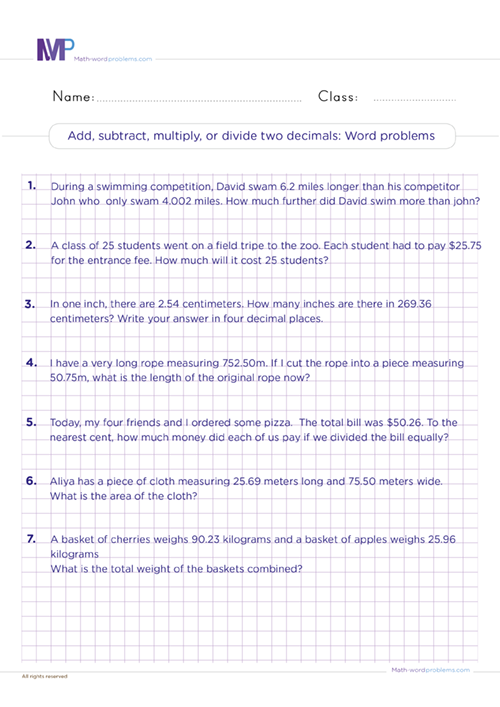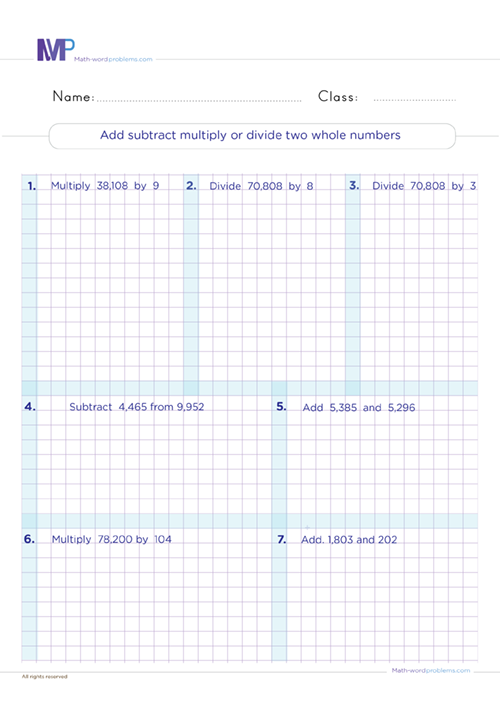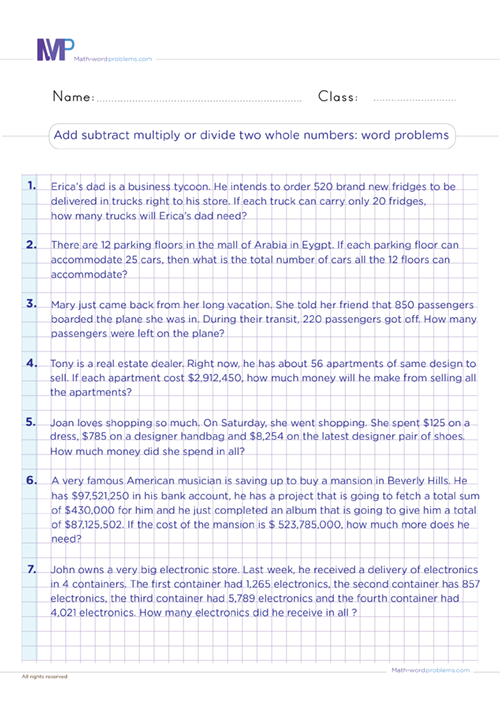 How to solve adding, subtracting, multiplying, and dividing decimals word problems
How to solve adding, subtracting, multiplying, and dividing decimals word problems

- INTRODUCTION
- Step 1 IDENTIFY
- Step 2 STRATEGIZE
- Step 3 SET UP
- Step 4 PROVIDE A SOLUTION
- Step 5 CHECK YOUR WORK
Get more contents on this skill...
Are you looking for an effortless way on how to solve adding, subtracting, multiplying, and dividing decimals word problems? You don’t have to look any further. Here is an engaging step-by-step guide on how to go about it.
As you know, learners in grade 6 usually face more challenging word problems on addition, subtraction, multiplication, and division of decimal numbers. That is why this guide is more focused on the effectiveness of kids in tackling these complex word problems, hence increasing their word problem-solving performance to why not 100%.
We equally assure you that these simple steps below will enable your learners to brush through any difficult grade 6 word problems on adding, subtracting, multiplying, and dividing decimals.
Steps to solve addition, subtraction, multiplication, and division of decimals word problems
Hey kids, here are the best steps to solve addition, subtraction, multiplication, and division of decimals word problems. With these steps, they will present higher achievement levels in solving world problems than before.
In addition, this basic problem-solving guide will offer kids the best skills, especially when solving situations in word problems involving indirect language, identifying relevant information, and problems with multiple steps.
Also, we’ve put together some fascinating examples to show you how accurately these steps work.
Step 1: IDENTIFY:
When moving on to this step, always read the problem very well and try to figure out the important numbers and keywords in the word problem.
- Firstly, if the word problem requires you to add decimal numbers, then you will see at least one of the keywords below: - add, plus, more, total, increase, together, Altogether, combine, sum, grow, join, both, in all, and, how many in all, how much, spend in all, etc.
- On the hand, if it is subtracting decimal numbers word problems, then you will encounter at least one of the keywords below in the word problem: - less, minus, take away, left, decrease, difference, fewer, deduct, remain, change, how many more, left over, less than, how much longer/shorter, how much more, fewer than, discount, etc.
- Thirdly, if it is multiplying decimal numbers word problems, then you will see at least one of the vital keywords below in the word problem: - times, multiplied by, product, product of, factor, of, multiply, times, multiple, double, triple, groups, by, twice, area, equal groups, every, in all, total, increased by, as much, each, lots of, groups of, per, etc.
- Finally, if it is dividing decimal numbers word problems, then you will see at least one of the keywords below in the word problem: - divide, half, evenly, every, per, parts, out of, quotient of, ratio of, how many in each, equal parts, cut up, average, as much, etc.
- ***One key Element for learners to understand is that they should not always rely on keywords alone. That is to say; the same keyword can have different meanings in different word problems.
- For this reason, we reiterate on the importance of reading the question very carefully to understand the situation that the word problem is describing, then figure out exactly which operation to use***
Step 2: STRATEGIZE:
How will you solve or tackle the word problem?
- Now, from the keyword(s) in the word problem, you will know if you will add, subtract, multiply or divide.
- But then again, you must not depend only on keywords. Rather, try to understand the situation that the problem is describing by reading the problem in-between the lines.
- Then, after knowing which operation you will perform, Construct short expressions/sentences to represent the given word problem.
Step 3: SET UP:
Step 4: PROVIDE A SOLUTION:
Step 5: CHECK YOUR WORK:
Examples on how to add, subtract, multiply and divide decimals word problems.
Example one: how to subtract decimals word problems.
Step 1: After carefully reading the word problem, the important numbers here are $578.25 and $578.9. Also, the keyword found in the word problem is “how much more.”
How do you solve the problem?
Step 2: So, how will you solve the problem? From the situation that the problem is describing and the keyword found in the word problem, you probably need to perform a subtraction operation.
Then after knowing which operation you will perform, construct short expressions/sentences to represent the given word problem.
- Cost of the laptop in the store = $578.25
- Cost of the laptop online = $578.9
- Therefore, how much more is the cost of the laptop online than in the store = The cost of the laptop online – The cost of the laptop in the store.
Step 3: Now, write down a numerical expression/ a mathematical equation to represent the bolded sentence in step 2 above:
→ $578.9 - $578.25 =?
Step 4: Then arrange or stack the values so that the decimal points line up in the minuend, subtrahend, and difference (i.e., using the column method of subtraction). Also, use zeros as place value holders if necessary, not forgetting to add the unit of measurement in your final answer, if any.
So, the laptop cost $0.65 more online than in the store.
Step 5: Finally, check out your work, i.e., if the answer makes sense by estimating the numbers and calculating mentally. If your estimated answer is so close to the one you have, then your answer is correct but if your estimated answer is not close to your answer, then go back to step 1.
Example two: how to add decimals word problems.
Step 1: the important numbers here are 114.7 pounds, 48.02 pounds, and 89.84 pounds. The keyword found in the word problem is “in all.”
How do you solve the problem?
Step 2: Next, how will you solve the problem? The keyword(s) “in all” found in the word problem calls for you to use addition. Also, apart from the keyword, the situation that the word problem describes calls for you to use an addition operation.
Now, after knowing which operation you will perform, Construct short expressions/sentences to represent the given word problem.
- Ethan’s weight = 114.7 pounds
- Michael’s weight = 48.02 pounds.
- Daniel’s weight = 89.84 pounds.
- Therefore, their total weight = Ethan’s weight + Michael’s weight + Daniel’s weight.
Step 3: Then, write down a numerical expression/ mathematical equation to represent the bolded statement /sentence in step 2 above:
→ 114.71 pounds + 48.02 pounds + 89.84 pounds =?
Step 4: After that, you need to arrange or stack the values so that the decimal points line up in the addends and sum. Also, use zeros as place value holders if necessary. Then, go ahead and add the values. Do not forget to add the unit of measurement to your final answer if any.
So, they weigh 252.57 pounds in all.
Step 5: Finally, check out your work to see if your answer makes sense, i.e., by estimating the numbers and doing mental calculations. If the answer is so close to the one you have, then your answer is correct but if the answer is not close to the one you have, then go back to step 1.
Example three: here is how to divide decimals word problems.
Step 1: Start by reading the word problem discretely and then figuring out the important numbers which are $50.26 and 5 (five friends). Also, the keyword(s) found in the word problem are “each”, and “equally”.
How do you solve the problem?
Step 2: At this point, you ask yourself, “how will I solve the problem?” As you can see from the situation that the problem is describing and the keyword(s) found in the word problem, you have to use a division operation.
After knowing which operation you will perform, Construct short expressions/sentences to represent the given word problem.
- Total amount of the bill = $50.26
- Number of people that divided the bill = 5
- Therefore, the amount of money each person paid = the amount of the bill ÷ the number of people that divided the bill.
Step 3: Now, write down a numerical expression to solve this word problem:
→ $50.26 ÷ 5 = ?
Step 4: Set up a long division sign, arrange the numbers on it, and then solve (follow the long division steps). Always remember to attach the unit of measurement to your final answer if any.
$10.052 to the nearest cent is $10.05
So, each person paid $10.05.
Step 5: Lastly, check out your work to know if your answer makes sense i.e., by estimating the numbers and doing mental calculations. If your estimated answer is so close to the one you have, then your answer is correct but if your estimated answer is not close to your answer, then go back to step 1.
Example four: How to multiply decimals word problems.
Step 1: As you can see, the important numbers here are 25.69 and 75.50. Also, the keyword(s) found in the word problem is “area.”
How do you solve the problem?
Step 2: Moving on to this step, how will you solve the problem? Judging from the situation that the problem is presenting and the keyword(s) found in the word problem, it calls for you to perform a multiplication operation.
Then, after knowing which operation you will perform, construct short expressions/sentences to represent the given word problem.
- Length of the piece of cloth = 25.69m
- Width of the piece of cloth = 75.50m
- Therefore, the area of the cloth = Length of the piece of cloth × Width of the piece of cloth.
Step 3: Now, write down a mathematical equation to solve this word problem:
→ 25.69m × 75.50m = ?
Step 4: After that, multiply the numbers using regrouping or any other multiplication methods like long multiplication, grid multiplication, and lattice method to determine the result. Furthermore, always add the unit of measurement to your final answer if any.
Also, since it is multiplication of decimals, we need to multiply the values as if they are whole numbers while ignoring the decimal points.
Then, count the number of digits after the decimal in each given factor.
Now, put the same number of digits behind the decimal in the product.
So, the area of the piece of cloth is 1,939.595 square meters.
Step 5: Finally, check out your work to know if your answer makes sense i.e., by estimating the numbers and doing mental calculations. If your estimated answer is so close to the one you have, then your answer is correct but if your estimated answer is not close to your answer, then go back to






→ this is a place value holder